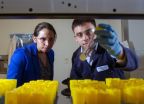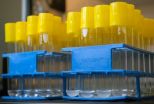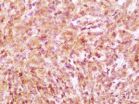(Press-News.org) Researchers at the Georgia Institute of Technology and the Joint BioEnergy Institute have engineered a bacterium to synthesize pinene, a hydrocarbon produced by trees that could potentially replace high-energy fuels, such as JP-10, in missiles and other aerospace applications. With improvements in process efficiency, the biofuel could supplement limited supplies of petroleum-based JP-10, and might also facilitate development of a new generation of more powerful engines.
By inserting enzymes from trees into the bacterium, first author and Georgia Tech graduate student Stephen Sarria, working under the guidance of assistant professor Pamela Peralta-Yahya, boosted pinene production six-fold over earlier bioengineering efforts. Though a more dramatic improvement will be needed before pinene dimers can compete with petroleum-based JP-10, the scientists believe they have identified the major obstacles that must be overcome to reach that goal.
Funded by Georgia Tech startup funds awarded to Peralta-Yahya's lab and by the U.S. Department of Energy's Office of Science, the research was reported February 27, 2014, in the journal ACS Synthetic Biology.
"We have made a sustainable precursor to a tactical fuel with a high energy density," said Peralta-Yahya, an assistant professor in the School of Chemistry and Biochemistry and the School of Chemical and Biomolecular Engineering at Georgia Tech. "We are concentrating on making a 'drop-in' fuel that looks just like what is being produced from petroleum and can fit into existing distribution systems."
Fuels with high energy densities are important in applications where minimizing fuel weight is important. The gasoline used to power automobiles and the diesel used mainly in trucks both contain less energy per liter than the JP-10. The molecular arrangement of JP-10, which includes multiple strained rings of carbon atoms, accounts for its higher energy density.
The amount of JP-10 that can be extracted from each barrel of oil is limited, and sources of potentially comparable compounds such as trees can't provide much help. The limited supply drives the price of JP-10 to around $25 per gallon. That price point gives researchers working on a biofuel alternative a real advantage over scientists working on replacing gasoline and diesel.
"If you are trying to make an alternative to gasoline, you are competing against $3 per gallon," Peralta-Yahya noted. "That requires a long optimization process. Our process will be competitive with $25 per gallon in a much shorter time."
While much research has gone into producing ethanol and bio-diesel fuels, comparatively little work has been done on replacements for the high-energy JP-10.
Peralta-Yahya and collaborators set out to improve on previous efforts by studying alternative enzymes that could be inserted into the E. coli bacterium. They settled on two classes of enzymes – three pinene synthases (PS) and three geranyl diphosphate synthases (GPPS) – and experimented to see which combinations produced the best results.
Their results were much better than earlier efforts, but the researchers were puzzled because for a different hydrocarbon, similar enzymes produced more fuel per liter. So they tried an additional step to improve their efficiency. They placed the two enzymes adjacent to one another in the E. coli cells, ensuring that molecules produced by one enzyme would immediately contact the other. That boosted their production to 32 milligrams per liter – much better than earlier efforts, but still not competitive with petroleum-based JP-10.
Peralta-Yahya believes the problem now lies with built-in process inhibitions that will be more challenging to address.
"We found that the enzyme was being inhibited by the substrate, and that the inhibition was concentration-dependent," she said. "Now we need either an enzyme that is not inhibited at high substrate concentrations, or we need a pathway that is able to maintain low substrate concentrations throughout the run. Both of these are difficult, but not insurmountable, problems."
To be competitive, the researchers will have to boost their production of pinene 26-fold. Peralta-Yahya says that's within the range of possibilities for bioengineering the E. coli.
"Even though we are still in the milligrams per liter level, because the product we are trying to make is so much more expensive than diesel or gasoline means that we are relatively closer," she said.
Theoretically, it may be possible to produce pinene at a cost lower than that of petroleum-based sources. If that can be done – and if the resulting bio-fuel operates well in these applications – that could open the door for lighter and more powerful engines fueled by increased supplies of high-energy fuels. Pinene dimers, which result from the dimerization of pinene, have already been shown to have an energy density similar to that of JP-10.
INFORMATION:
Co-authors from the Joint BioEnergy Institute included Betty Wong, Hector Garcia Martin and Professor Jay D. Keasling, co-corresponding author of the paper.
CITATION: Stephen Sarria, et al., "Microbial Synthesis of Pinene," (ACS Synthetic Biology, 2014). (http://dx.doi.org/10.1021/sb4001382).
This work was started at the DOE Joint BioEnergy Institute (JBEI) and finished at the Georgia Institute of Technology. The work at JBEI was funded by the U.S. Department of Energy, Office of Science, Office of Biological and Environmental Research through contract DE-AC02-05CH11231 between Lawrence Berkeley National Laboratory and the U.S. Department of Energy. The work at the Georgia Institute of Technology was funded by startup funds awarded to the Peralta-Yahya laboratory. Any opinions expressed are those of the authors and do not necessarily represent the official views of the DOE.
Engineered bacteria produce biofuel alternative for high-energy rocket fuel
2014-03-26
ELSE PRESS RELEASES FROM THIS DATE:
Ancient sea creatures filtered food like modern whales
2014-03-26
The animals lived 520 million years ago during the Early Cambrian, a period known as the 'Cambrian Explosion' in which all the major animal groups and complex ecosystems suddenly appeared. Tamisiocaris belongs to a group of animals called anomalocarids, a type of early arthropod that included the largest and some of the most iconic animals of the Cambrian period. They swam using flaps down either side of the body and had large appendages in front of their mouths that they most likely used to capture larger prey, such as trilobites.
However, the newly discovered fossils ...
First ring system around asteroid
2014-03-26
The rings of Saturn are one of the most spectacular sights in the sky, and less prominent rings have also been found around the other giant planets. Despite many careful searches, no rings had been found around smaller objects orbiting the Sun in the Solar System. Now observations of the distant minor planet [1] (10199) Chariklo [2] as it passed in front of a star have shown that this object too is surrounded by two fine rings.
"We weren't looking for a ring and didn't think small bodies like Chariklo had them at all, so the discovery — and the amazing amountof detail ...
Gut metabolism changes -- not stomach size -- linked to success of vertical sleeve gastrectomy
2014-03-26
CINCINNATI—It's not the size of the stomach that causes weight loss after a specific type of bariatric surgery, but rather a change in the gut metabolism, say researchers from the University of Cincinnati (UC), the University of Gothenburg in Sweden and Cincinnati Children's Hospital Medical Center.
The scientists, publishing their results in the March 26, 2014, advanced online edition of Nature, have found that following vertical sleeve gastrectomy, there is a change in bile acids that bind to a nuclear receptor called FXR. In the absence of FXR, the researchers showed, ...
Some breast cancer tumors hijack patient epigenetic machinery to evade drug therapy
2014-03-26
PITTSBURGH, March 26, 2014 – A breast cancer therapy that blocks estrogen synthesis to activate cancer-killing genes sometimes loses its effectiveness because the cancer takes over epigenetic mechanisms, including permanent DNA modifications in the patient's tumor, once again allowing tumor growth, according to an international team headed by the University of Pittsburgh Cancer Institute (UPCI).
The finding warrants research into adding drugs that could prevent the cancer from hijacking patients' repressive gene regulatory machinery, which might allow the original therapy ...
First comprehensive atlas of human gene activity released
2014-03-26
Boston, MA — A large international consortium of researchers has produced the first comprehensive, detailed map of the way genes work across the major cells and tissues of the human body. The findings describe the complex networks that govern gene activity, and the new information could play a crucial role in identifying the genes involved with disease.
"Now, for the first time, we are able to pinpoint the regions of the genome that can be active in a disease and in normal activity, whether it's in a brain cell, the skin, in blood stem cells or in hair follicles," said ...
Brain degeneration in Huntington's disease caused by amino acid deficiency
2014-03-26
Working with genetically engineered mice, Johns Hopkins neuroscientists report they have identified what they believe is the cause of the vast disintegration of a part of the brain called the corpus striatum in rodents and people with Huntington's disease: loss of the ability to make the amino acid cysteine. They also found that disease progression slowed in mice that were fed a diet rich in cysteine, which is found in foods such as wheat germ and whey protein.
Their results suggest further investigation into cysteine supplementation as a candidate therapeutic in people ...
Cosmic collision creates mini-planet with rings
2014-03-26
Until now, rings of material in a disc have only been observed around giant planets like Jupiter, Uranus, Neptune and especially Saturn, which is known for its spectacular rings. Now astronomers from the Niels Bohr Institute, among others, have observed the first miniature planet with two rings of ice and pebbles. It is a smaller celestial body, called Chariklo, located two billion kilometers out in the solar system between Saturn and Uranus. The results are published in the prestigious scientific journal, Nature.
Chariklo was located in the Kuiper Belt, a collection ...
New maps for navigating the genome unveiled by scientists
2014-03-26
Scientists have built the clearest picture yet of how our genetic material is regulated in order to make the human body work.
They have mapped how a network of switches, built into our DNA, controls where and when our genes are turned on and off.
University of Edinburgh scientists played a leading role in the international project – called FANTOM5 – which has been examining how our genome holds the code for creating the fantastic diversity of cell types that make up a human.
The three year project, steered by the RIKEN Center for Life Science Technologies in Japan, ...
Keeping secrets in a world of spies and mistrust
2014-03-26
VIDEO:
This is an interview with Professor Artur Ekert, co-inventor of quantum cryptography, about what it takes to keep secrets secret.
Click here for more information.
Revelations of the extent of government surveillance have thrown a spotlight on the security – or lack thereof – of our digital communications. Even today's encrypted data is vulnerable to technological progress. What privacy is ultimately possible? In the 27 March issue of Nature, the weekly international ...
Cell-saving drugs could reduce brain damage after stroke
2014-03-26
Long-term brain damage caused by stroke could be reduced by saving cells called pericytes that control blood flow in capillaries, reports a new study led by scientists from UCL (University College London).
Until now, many scientists believed that blood flow within the brain was solely controlled by changes in the diameter of arterioles, blood vessels that branch out from arteries into smaller capillaries. The latest research reveals that the brain's blood supply is in fact chiefly controlled by the narrowing or widening of capillaries as pericytes tighten or loosen around ...






